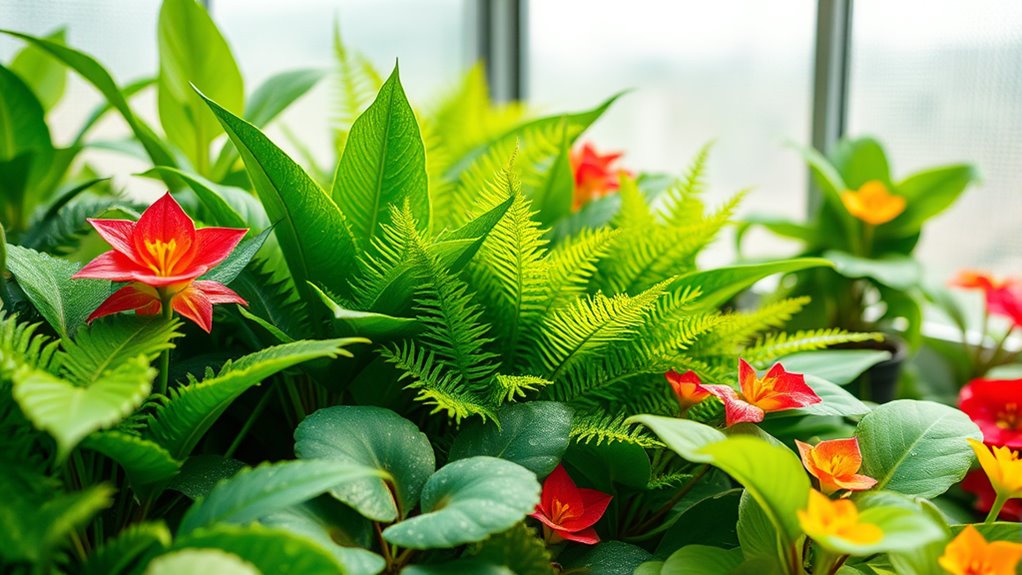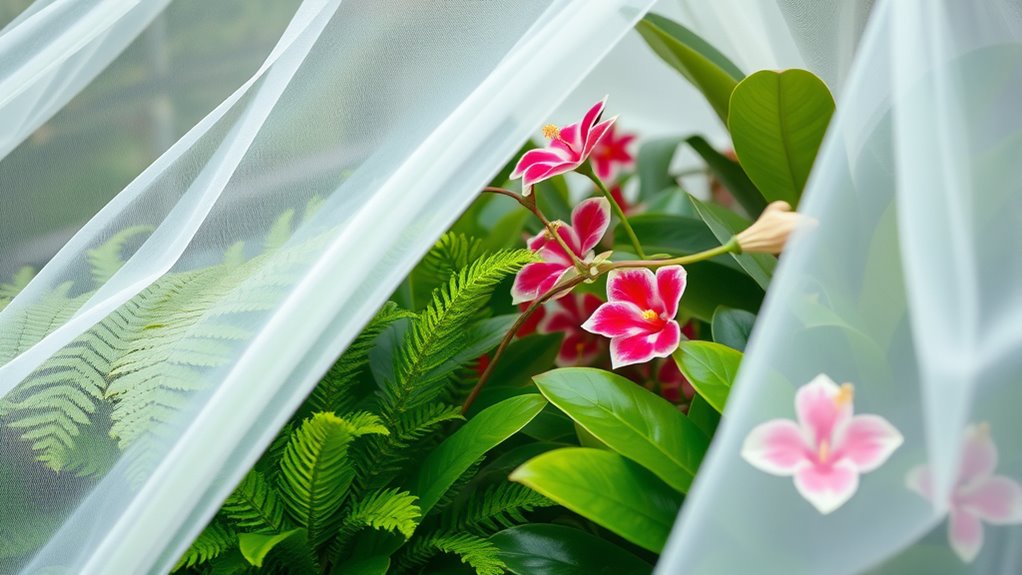To overwinter tropicals and tender crops in your greenhouse, keep temperatures steady between 55°F and 70°F using thermostats and supplemental heat if needed. make certain good airflow with fans or vents, and lower humidity to prevent pests and diseases. Regularly inspect for pests, quarantine new plants, and keep the environment clean by removing debris. Proper equipment and environmental controls are essential. If you want detailed tips, continue exploring effective strategies for winter plant protection.
Key Takeaways
- Maintain consistent temperatures between 55°F and 70°F to prevent cold stress on tropical and tender plants.
- Use appropriate heating systems and supplemental heat sources to ensure stable warmth during winter.
- Ensure proper ventilation and humidity control to reduce pests, mold, and disease risks.
- Conduct regular plant inspections, sanitation, and quarantine new plants to prevent pest and disease issues.
- Keep the greenhouse clean and monitor equipment to support healthy overwintering conditions for tender crops.

As winter approaches, many gardeners turn to their greenhouses to protect and preserve valuable plants. If you’re overwintering tropicals and tender crops, maintaining ideal conditions inside your greenhouse becomes vital. Proper temperature control is at the heart of successful overwintering, ensuring your plants stay healthy and avoid cold damage. You want to keep the temperature steady, ideally between 55°F and 70°F, depending on the specific needs of your plants. Use thermostats and heating systems to prevent sudden drops that could stress or kill your plants. Supplemental heat sources, like electric heaters or heated mats, can help maintain consistent warmth during colder months. Ventilation is equally important to avoid overheating during sunny days and to reduce humidity levels that can foster pests and diseases.
Alongside temperature control, pest management takes on a critical role in your winter greenhouse routine. As plants are kept in close quarters, pests like aphids, whiteflies, and spider mites can quickly become problematic, especially in the humid environment of winter greenhouses. Regular inspections are your first line of defense; look for signs of pests or disease and act swiftly if you notice any trouble. Introducing beneficial insects, such as ladybugs or predatory mites, can naturally control pest populations without the need for harsh chemicals. Keep your greenhouse clean and remove any fallen leaves or debris that could harbor pests or pathogens. Using physical barriers, sticky traps, and organic pest control sprays can further reduce infestations and keep your plants healthy.
To prevent pest outbreaks, managing humidity levels is essential. High humidity creates an ideal environment for mold, mildew, and pests to thrive, so ensure good airflow with fans or vents. Avoid overwatering, which increases humidity and can lead to root rot, by watering only as needed. Keep the greenhouse sanitized, and quarantine new plants before introducing them to your existing collection to prevent pests from hitchhiking in. Additionally, understanding the electricity and heating needs of your greenhouse equipment helps maintain consistent temperatures and keeps pest issues at bay.
Frequently Asked Questions
Can I Overwinter Houseplants Alongside Outdoor Tropicals?
Yes, you can overwinter houseplants alongside outdoor tropicals if you guarantee they get enough indoor light and are protected from cold drafts. Keep the soil well insulated around roots with mulch or root insulation to prevent freezing. Place your houseplants where they’ll receive bright, indirect light, and maintain consistent temperatures. This combined approach helps both indoor and outdoor plants survive winter, saving you time and effort.
How Do I Prevent Pests During Overwintering?
To prevent pests during overwintering, you should start with pest prevention measures like inspecting plants thoroughly before bringing them inside. Use insect barriers such as fine mesh screens or sticky traps to catch any unwanted visitors. Keep your greenhouse clean and free of debris, and regularly check for signs of pests. Quarantine new plants, and treat any infestations promptly with organic insecticides to protect your valuable tropicals and tender crops.
What Are Common Mistakes in Greenhouse Winter Care?
You might overlook maintaining a proper watering schedule or neglect temperature regulation during winter. Avoid overwatering, which can cause root rot, and under-watering, leading to dehydration. Make certain of consistent temperatures to prevent stress and disease. Don’t forget to check humidity levels and ventilation regularly. These common mistakes can harm your plants, so stay vigilant, adjust your care routine as needed, and keep a close eye on environmental conditions to promote healthy overwintering.
How Do I Monitor Humidity Levels Effectively?
Monitoring humidity levels is like keeping a close eye on a delicate dance—balance is key. Use a reliable hygrometer for accurate humidity monitoring, and place it in different spots to get a true reading. To make certain of effective control, adjust vents, use humidifiers or dehumidifiers, and regularly check levels. Consistent monitoring helps you maintain the ideal environment, protecting your tender crops from stress or disease during winter.
When Should I Start the Overwintering Process?
You should start overwintering your plants as temperatures begin to drop consistently below 50°F, typically in late fall. Begin with seasonal pruning to reduce stress and encourage healthy dormancy. Adjust your greenhouse’s temperature regulation to maintain a stable environment, preventing cold damage. Starting early guarantees your tropicals and tender crops adapt gradually, minimizing shock and maximizing their chances of thriving through winter.
Conclusion
By overwintering your tropicals and tender crops in your greenhouse, you’re fundamentally creating a tiny paradise that defies the harshest winter storms. With just a little effort, you’ll turn your space into a lush, year-round jungle where plants thrive against all odds. So, go ahead—protect those precious plants, and watch as they flourish like they’ve been on a tropical vacation forever. Your greenhouse will become the ultimate plant sanctuary you never knew you needed!









